My Facebook newsfeed is rife with posted articles on the recent escalation of conflict in Israel. There is a lot of commentary and passionate debate.
I am so NOT an expert on the issue or the history, although I consider myself somewhat well-read. Â In a nutshell, the British (self-appointed rulers of the Galaxy and my ancestry of origin on my father’s side) thought it was a good idea to grant the land of Palestine to a highly oppressed, ostracized group (Jews) without sufficient provision for, or acknowledgement or, or discussion with, the then occupants of that land (Palestinians). If someone tried this on my street, there would be hell to pay.
(Oh, wait … the British did try this here … and First Nations peoples are still reeling from our thoughtless and arrogant mismanagement …)
Here are three of the most thought-provoking, and heart-wrenching, articles I’ve read so far:
Israelis and Palestinians have been attacking and killing each other, literally, for as long as I can remember, and I realize now, for at least 40 years before my memories started to form. I was an avid news watcher when growing up and I distinctly recall having some child-like narcissistic fantasy about being the mediator between Golda Meir and Yassar Arafat and being able to make them see that they didn’t need to kill each other’s children anymore. Everyone could be friends … all you need is love … or something similar. After all, how can some parts of the world be so consistently peaceful and other parts be so consistently violent? We should just share some of our Canadian peacenik-ness with the Middle East and all would be well. Cue patchouli incense.
Fast forward 40+ years and, although I have long ditched the fantasy of being the wise and all-knowing mediator, the map, the patterns, the headlines … the basic gist of what is transpiring looks about the same now as it did then. I understand the complexities and chasms more, now, but the overarching specter of two ancient peoples bashing the hell out of each other looks startlingly similar to what it did on my parents’ fuzzy tv when the news came on.
The Middle East is very hot. There isn’t really enough drinkable water to go around. And many peoples hold that one piece of land is, sacredly and historically, “theirs”.
Until this last item is settled in some way that all parties can live with, literally, I doubt the map, patterns, or headlines will change significantly in the next 40 years. There is no peace-nik sensibility strong enough to blur the scars, the hurt and the tragedy of that which continues to unfold.
For what small good it does, if you believe in such things as chaos theory, I’m going to light some incense tonight. In memory of all who have died, and in faint, fragrant hope that some solution is imminent.
The Dachau Concentration Camp Memorial site is set up to educate with as much clarity and sensitivity as possible while also 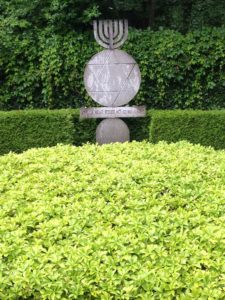 memorializing the tragic brutality that this ground witnessed. There are multiple sculptures, plaques, monuments, etc. that commemorate the victims and the crimes perpetrated. Newer buildings are on site as memorials, sponsored by multiple faiths that had clergy/leaders/members in the camp, including obviously a Jewish representation but also Catholic, Protestant, and Russian Orthodox. One of the buildings is currently in use as a nunnery.
memorializing the tragic brutality that this ground witnessed. There are multiple sculptures, plaques, monuments, etc. that commemorate the victims and the crimes perpetrated. Newer buildings are on site as memorials, sponsored by multiple faiths that had clergy/leaders/members in the camp, including obviously a Jewish representation but also Catholic, Protestant, and Russian Orthodox. One of the buildings is currently in use as a nunnery.
There is no minimizing, dodging or obfuscating the role of this camp, the first concentration camp, in setting the tone for other camps. Everything that was done elsewhere started here. Given all the things I saw as testament to the crimes and death that occurred … what is really a struggle for me is understanding how vast the network of camps and sub-camps was. We were shown a map of the territories held by Germany at the peak of the war and the map was filled with literally hundreds of locations where versions of this place, in smaller and larger scales, were located. We have heard only of a handful of the usual names – Auschwitz-Birchenau, Treblinka, Bergen-Belsen, Dachau. But there were literally hundreds of camps and sub-camps. I was aghast at the breadth and scope of barbarism undertaken across such a wide geographic area.
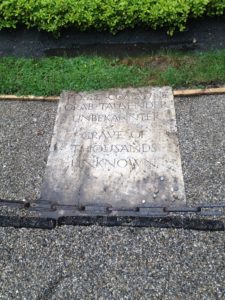
Grave to mark ashes of thousands of unknowns (Jewish Memorial)
During my visit, it was (mostly) quiet. People were respectful and clearly there to learn, to try to comprehend, to absorb. Entrance to the site is free. I’d estimate there were a few thousand people there while I was there, so it is well used. There are lots of trees around the exterior of the camp proper, and thus lots of birds singing. That seemed out of place, as if the birds should know better. It poured rain, on and off, and that seemed entirely in keeping with the mood. Our tour group had 15 high school kids from Indiana and it was interesting to watch them go from being “too cool for this” and sort of detached to being really quite sober. I overheard discussion of the use of this memorial site for school groups and it appears that schools from all over Europe and North America make stops here. That feels like a good thing, but it does make it a bit of a challenge for maintaining the appropriate decorum when pre-teens and teens are responding to what they see with humour or (feigned) apathy. I think Dachau has an impact on everyone who visits and I think it is important for as many young people from as many different backgrounds as possible to see it – and I also think that kids don’t always know what to do with their emotional responses “in the moment”.
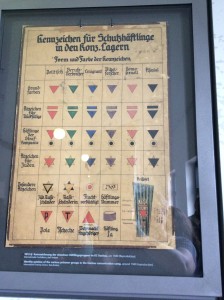
The Original Pink Triangle
It felt oddly synchronous to be looking at the actual original pink triangle symbol, as deployed to identify a homosexual “enemy of the state”, the day after World Pride had wrapped up in my home city of Toronto. There is no more clear reason to justify the existence of an event like “World Pride” than standing in an original building at Dachau and looking an original wall chart of symbols used to identify people, one of which was a pink triangle. Interestingly, there is a committee of survivors that has a crucial role in determining the types of memorials that will be allowed. A memorial focusing on homosexuals is absent because, in the hierarchy / social structure of the camp at the time, homosexuals were at the bottom of the barrel along with known criminals and other “asocials”. The committee of survivors isn’t comfortable acknowledging the targeting of homosexuals by approving a memorial for this group. When I spoke to our guide about this privately, he suggested that people were waiting for the committee of survivors (which is quite small now) to hand over their legacy to perhaps a more current committee with a more current perspective. I would have liked to have seen something there as an acknowledgement that gay people were one of the many groups identified as “enemies of the state” – and I also think this can wait until the time is right. Homosexuals are identified within the part of the exhibit that describes all the targeted groups, and our situation is given as much detail and focus as most of the other groups.
I took only a handful of pictures. It didn’t seem … seemly.
Dachau is just outside of Munich and the typical journey one takes to get there is from the Hauptbahnhof (main train station) in Munich. It is a short 10-15 minute ride. German citizens in Munich are extremely sensitive about people coming to visit to learn more about Nazis and about concentration camps. I knew about specific laws around giving an Nazi salute (even in jest, this will get you arrested) and I didn’t realize Mein Kampf was still a banned book. It was odd to be taking a tour with a group to specific sites relevant to WWII and to be scrutinized by the locals. They will listen and try to be sure the guide isn’t Munich-bashing or sensationalizing. Locals are also concerned with Neo-Nazis using specific sites as touchstones for their own purposes. As much as they don’t want their quite beautiful city associated with the rise of the Nazi party, as it happens, this is now a key part of the city’s past. Never mind that the PLO leveraged this association with the murders during the Olympics in 72, which adds another horrific piece to the global perception of Munich. I don’t want to suggest that Munich has had a bad rap – it is what it is – but it is a pleasant place, rich in layers of history beyond the 20th Century, walkable, reasonably friendly – I quite enjoyed it.
There are lots of very subtle, slightly subversive, commemorative elements in Munich. Many bullet holes and other types of damage have
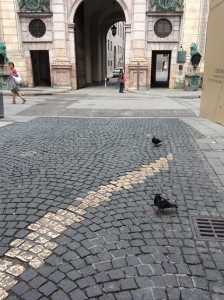
Dodger’s Alley
been left, on purpose, unrepaired, in the architecture, like reminders. Scars. You have to look for these, but they are there. A more deliberate, striking example is a metallic (gold? bronze?) shimmering trail down the cobblestones in an alleyway known as Dodger’s Alley. In the 30’s/40’s, citizens of Munich who walked by a specific Nazi plaque on the corner of one of the main squares had to give a Nazi salute or be arrested for not doing so. There were lots of people who didn’t want to give a Nazi salute. So, to avoid walking by that plaque, many would take a detour down Dodger’s Alley. Nazi authorities caught on to this and started policing the use of the alley, interrogating people found in the alley as to their purpose for being there. If no satisfactory purpose was offered, a person would be thrown immediately into Dachau. Just for taking a detour to avoid giving a salute. Even these people were “enemies of the state”. As to the metallic trail, there is no plaque or explanation. You need to just know, or be told, why it is there and what it signifies. Apparently, there are lots of these sorts of things all over the city, commemorations of resistance. I didn’t have time to go find more, unfortunately.
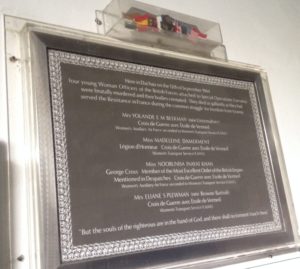
Four Heros You Need to Know About
I will close by noting this plaque. It is almost hidden behind a door that leads from the gas chamber into the crematorium. (Please don’t imagine that I typed that sentence with any degree of casualness.) There is a railing in place, making it harder to get a straight on, close photo. Since it is hard to read, I’ll type out what it says here. They gave their lives – the least I can do is try to get this right.
Here in Dachau on the 12th of September 1944
four young Woman Officers of the British Forces attached to Special Operations Executive
were brutally murdered and their bodies cremated. They died as gallantly as they had
served the Resistance in France during the common struggle for freedom from tyranny.
Mrs. YOLANDE E M BEEKMAN (nee Unternahrer)
Croix de Guerre avec etoile de Vermeil
Women’s Auxiliary Air Force seconded to Women’s Transport Service (F.A.N.Y.)
Miss MADELEINE DAMERMENT
Legion d’Honneur Croix de Guerre avec etoile de Vermeil
Women’s Transport Service (F.A.N.Y.)
Miss NOORUNISA INAYAT KHAN
George Cross Member of the Most Excellent Order of the British Empire
Mentioned in Dispatches Croix de Guerre avec etoile de Vermeil
Women’s Auxiliary Air Force seconded to Women’s Transport Service (F.A.N.Y.)
Mrs ELIANE S PLEWMAN (nee Browne-Bartoli)
Croix de Guerre avec etoile de Vermeil
Women’s Transport Service (F.A.N.Y.)
“But the souls of the righteous are in the hand of God, and there shall be no torment touch them”
Bravery, compassion and a complete and utter focus on their missions, to the exclusion of all else, including their own lives. This was a surprise find towards the end of my visit to Dachau – but it shouldn’t have been. I feel like I should know these names and that I should know more about these stories. Their world, a world in which their skills and dedication were needed at extreme cost, is not that far removed from our current time of social media, popular culture, ridiculous fads and trivial pursuits.
Do not forget.
If you are a history nerd/buff and are visiting Munich, you must look up Taff Simon/Dark History Tours. I know of no other tour guide who carries centuries worth of props, artifacts, costumes and even a sword around with him to augment his story-telling. (What a work out that must be!)
I had some plans change at the last minute and found Taff by googling something like “what to do in Munich”. We had an email exchange and he wound up adding me to the end of his long day of group tours for a quick walk around downtown in the early evening. This was above and beyond, in my opinion, and I learned more in that short few hours than ever expected to. I peppered him with questions on such a wide range of historical eras – from ancient tribes in the area to WWII – and he fielded them all. Taff is a trained and experienced archaeologist and historian with a clear passion for all things historical.
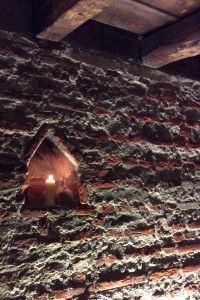
They don’t make them like this anymore.
We stopped for a beer – everyone drinks beer in Munich – in the oldest pub in the city. These bricks were hand formed over 600 years ago – some of the finger impressions in the bricks are still visible.
I learned more new facts about the rise of National Socialism in Munich, including the early location of the Gestapo headquarters and the dining hall where Kristallnacht was likely planned and set in motion by all the leading Nazi figures of the time. Other tours take some of the standard approaches, and these are key too – the Beer Hall Putsch, the locations of early Nazi rallies, the struggle of today’s citizens of Munich to acknowledge their city’s dark role in the establishment of the roots of Nazism. Taff adds extra detail to flesh out these elements and make them come alive.
In one of the courtyards towards the end of our tour, he demonstrated what a medieval man of status would look like, pulling out costume items and accessories, all the while discussing the whys and wherefores of each item. The courtyard we were in has historical significance through many periods of time, including being used as a marketplace where men in his style of dress would have been present. It was engaging, fascinating and fun.
Taff is obviously a walking 3D History Channel and it is worth a detour to Munich, if you hadn’t planned to be there, just to hang out with him. If you are planning some time in Munich, you must look up Taff Simon and Dark History Tours. You will not regret it.
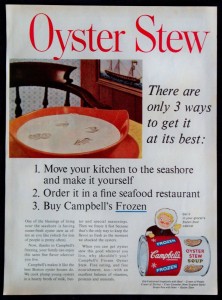
Ad for Campbell’s Frozen Oyster Stew, circa 1961
My Mom used to buy Campbell’s Frozen Oyster Stew for us to share at lunch. She didn’t do this often but it was a huge treat when she did. This buttery, creamy, slurpy soup with those funny rubbery fishy bits … I loved it.
This is really an odd sort of choice for my land-locked, Southern Ontario farming Mom. I wonder how she got “hooked” on this soup? Why not, if it is going to be a fishy stew, the more popular and known clam chowder?
Anyway – Â I quickly learned to love it too, at a relatively young age. And I do crave it from time to time. It hasn’t been available for years, unfortunately, and I wouldn’t know the first thing about trying to make it from scratch. The only oysters I know of are expensive appetizers in upscale restaurants in Toronto. I suppose there are tinned oysters but I can’t imagine putting them in a soup.
I woke up with this soup on my mind and, alas, had none available. I did have granola, Greek yogurt and a fresh peach so I made do with that.

Granola, yogurt, peach and coffee. An oyster stew substitute?
 memorializing the tragic brutality that this ground witnessed. There are multiple sculptures, plaques, monuments, etc. that commemorate the victims and the crimes perpetrated. Newer buildings are on site as memorials, sponsored by multiple faiths that had clergy/leaders/members in the camp, including obviously a Jewish representation but also Catholic, Protestant, and Russian Orthodox. One of the buildings is currently in use as a nunnery.
memorializing the tragic brutality that this ground witnessed. There are multiple sculptures, plaques, monuments, etc. that commemorate the victims and the crimes perpetrated. Newer buildings are on site as memorials, sponsored by multiple faiths that had clergy/leaders/members in the camp, including obviously a Jewish representation but also Catholic, Protestant, and Russian Orthodox. One of the buildings is currently in use as a nunnery.





